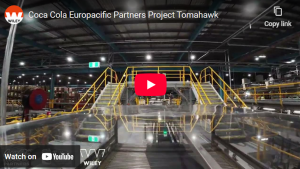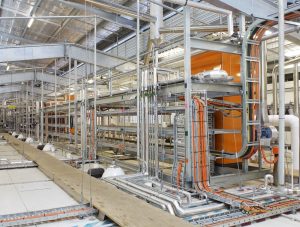
- Industry Type: Industrial Manufacturing, Warehousing, Refurbishment, Logistics, Food Processing, Cold Storage
- Author: Low Carbon Australia
- Service Area: Advice
- Date: 09 Aug 2012
Low Carbon Australia has solutions for manufacturers wanting to beat rising energy costs and improve productivity.
Low Carbon Australia finances proven energy efficiency equipment and clean technology projects that deliver cash flow benefits and energy savings.
CEO Meg McDonald said that Low Carbon Australia was working with a range of manufacturers to help them lower their energy costs straight away.
“Our finance is structured to meet the cash flow needs of the business and the project, providing savings, in many cases with no upfront capital required,” she said.

CEO Meg McDonald says Low Carbon Australia is working with manufacturers to help them lower their energy costs straight away.
“We cover all proven energy efficiency equipment, providing finance for projects including cogeneration and trigeneration units, compressed air and industrial process upgrades, installing energy efficient lighting, electric motors and power factor correction devices, and refrigeration.”
Established by the Australian Government in 2010, Low Carbon Australia is working across all sectors of the economy to help organisations move to a low carbon economy.
“The high Australian dollar has made it harder for local manufacturers to compete with imports,” Ms McDonald said.
“And while the recent attention has focused on introduction of carbon pricing, manufacturers face the reality that regardless of the carbon price, energy prices have been rising for some time and are expected to continue to do so due to a variety of factors, and so can be expected to continue to impact on business bottom lines.”
The Energy Users Association of Australia says prices have risen by as much as 40 per cent in the past five years, with a further rise of 30 per cent expected by the end of the 2013 financial year.
Manufacturers reducing their energy consumption by upgrading to more efficient equipment are ultimately reducing their exposure to these future price increases.
Research released by the Australian Industry Group in June, showed that of Australian businesses surveyed, three quarters of respondents had either taken action or were planning actions to improve energy efficiency.
The survey also showed there was a reluctance to invest in larger energy efficiency projects with longer payback periods.
“Many businesses investigate energy efficiency equipment options as a means to improve operations, contain costs and boost productivity, finding the finance to meet the upfront capital costs involved can prevent many businesses ,” Ms McDonald said.

Energy efficiency can be achieved by upgrading HVAC.
“Businesses also need to be confident that they’ve chosen the right technology solution before making the investment and which equipment would provide the most cost-effective savings.
“That’s where we’ve been able to help. We can provide solutions that bundle finance and technical expertise together, or, if you have already scoped a project we may be able to tailor finance that will suit your individual operating needs.”
To help get projects happening sooner, Low Carbon Australia has been working with a number of manufacturers who have sought funding through the Australian Government’s Clean Technology Programs.
One of Australia’s leading producers of high quality frozen meals, Crafty Chef, is expecting to cut its energy bills by over 50 per cent on a per unit basis, following the installation of a new $1.12 million refrigeration system, part financed by Low Carbon Australia and a CTP grant.

Crafty Chef celebrates their funding with Greg Combet, Minister for Industry and Innovation.
The new system which uses an ammonia refrigerant, will allow the company to expand production and reduce its costs while cutting its carbon emissions.
With refrigeration costs a concern for food production manufacturers, particularly since the impact of pricing through the Ozone Protection and Synthetic Greenhouse Gas Management legislation, there are other ways Low Carbon Australia’s energy efficiency finance can help.
For example, a pork abattoir can improve efficiency and competitiveness while reducing operating costs through upgrading its refrigeration system to one that will reduce its annual electricity consumption by 12 per cent and its LPG consumption by 7 per cent.

An ammonia compressor. Refrigeration is one area where energy savings can be realised through upgrades.
Low Carbon Australia’s finance used in conjunction with funding sourced through an Australian Government grant will help the abattoir cover the upfront cost of the $845,000 project that involves installing variable speed drives on the motors, facilitating compressor staging and capacity management and developing a waste heat to hot-water steam system.
Using hypothetical energy prices of15c/kWh for electricity and $25/GJ for liquid petroleum gas (LPG), the business could save $212,000 annually. Simple payback for the project is four years. That’s based on electricity prices remaining static. As prices rise, the project’s savings also rise.
Companies can also buffer themselves against such rises through cogeneration and trigeneration plants or by using waste products to generate their own power.
Ms McDonald said that intensive livestock industries were already well advanced in examining harnessing biogas from effluent.
“The potential is there to eliminate the need to draw electricity from the national grid and instead be in a position to export energy,” she said.
“For example, a piggery considering the installation of co-generation equipment to allow them to create energy and heat from effluent is looking at an investment of just under $1 million to construct two covered effluent ponds and install three gas engines fitted with cogeneration equipment,” she said.

Cogen equipment can help businesses reduce their reliance on electricity from traditional sources.
Photo provided courtesy of Simons Green Energy.
“Sourcing finance from Low Carbon Australia, means the piggery could undertake the project now, produce its own electricity, cut its LPG consumption and realise an annual cost saving of just under $250,000 with a payback period of just under four years.”
Again, as energy prices rise, the projected savings of such projects also rise.
But for those not in food or farming, there is still scope for energy saving by upgrading equipment that may be close to the end of its useful working life.
Ms McDonald said companies investigating their current equipment may well find that it is no longer cutting-edge technology, is racking up repair bills and doesn’t allow them to function at optimum productivity levels.
“Again, that’s where we can help with finance and energy efficiency solutions.”
For example, a business could potentially save $58,000 a year in costs and reduce its greenhouse gas emissions by 400 tonnes through upgrading its compressed air system.
To upgrade an existing 100 kilowatt compressed air system with a 55 kilowatt system, with no loss of air for production demands would mean a capital outlay of around $120,000.
However, with leasing finance through Low Carbon Australia and one of its co-finance partners, the business can upgrade now and use the energy savings made to cover the payments over a payback period of just over two years.
Once that lease timeframe expires, the energy savings go straight towards improving the business’s bottom line.
“Leasing is often an attractive alternative for manufacturers who want to keep their operations running at peak productivity levels,” Ms McDonald said.
“Through our partnerships with Origin, Macquarie, Alleasing and Flexigroup we offer operating and finance leases, hire purchase and deferred payment arrangements, and on-bill financing options to cover capital equipment acquisition and implementation costs.”
“And while we do work with those seeking Clean Technology Program grants, you don’t have to be eligible for a grant to talk to us about how our finance might suit your needs.”
To learn more about Low Carbon Australia, please visit www.lowcarbonaustralia.com.au or phone 1300 661 678.


